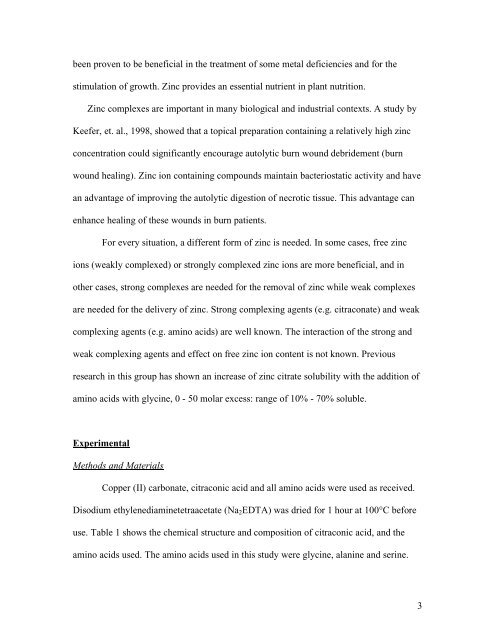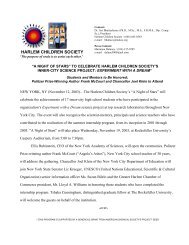Solubility of Copper (II) Citraconate
Research paper (pdf) - Harlem Children Society
Research paper (pdf) - Harlem Children Society
- No tags were found...
Create successful ePaper yourself
Turn your PDF publications into a flip-book with our unique Google optimized e-Paper software.
een proven to be beneficial in the treatment <strong>of</strong> some metal deficiencies and for the<br />
stimulation <strong>of</strong> growth. Zinc provides an essential nutrient in plant nutrition.<br />
Zinc complexes are important in many biological and industrial contexts. A study by<br />
Keefer, et. al., 1998, showed that a topical preparation containing a relatively high zinc<br />
concentration could significantly encourage autolytic burn wound debridement (burn<br />
wound healing). Zinc ion containing compounds maintain bacteriostatic activity and have<br />
an advantage <strong>of</strong> improving the autolytic digestion <strong>of</strong> necrotic tissue. This advantage can<br />
enhance healing <strong>of</strong> these wounds in burn patients.<br />
For every situation, a different form <strong>of</strong> zinc is needed. In some cases, free zinc<br />
ions (weakly complexed) or strongly complexed zinc ions are more beneficial, and in<br />
other cases, strong complexes are needed for the removal <strong>of</strong> zinc while weak complexes<br />
are needed for the delivery <strong>of</strong> zinc. Strong complexing agents (e.g. citraconate) and weak<br />
complexing agents (e.g. amino acids) are well known. The interaction <strong>of</strong> the strong and<br />
weak complexing agents and effect on free zinc ion content is not known. Previous<br />
research in this group has shown an increase <strong>of</strong> zinc citrate solubility with the addition <strong>of</strong><br />
amino acids with glycine, 0 - 50 molar excess: range <strong>of</strong> 10% - 70% soluble.<br />
Experimental<br />
Methods and Materials<br />
<strong>Copper</strong> (<strong>II</strong>) carbonate, citraconic acid and all amino acids were used as received.<br />
Disodium ethylenediaminetetraacetate (Na 2 EDTA) was dried for 1 hour at 100°C before<br />
use. Table 1 shows the chemical structure and composition <strong>of</strong> citraconic acid, and the<br />
amino acids used. The amino acids used in this study were glycine, alanine and serine.<br />
3



